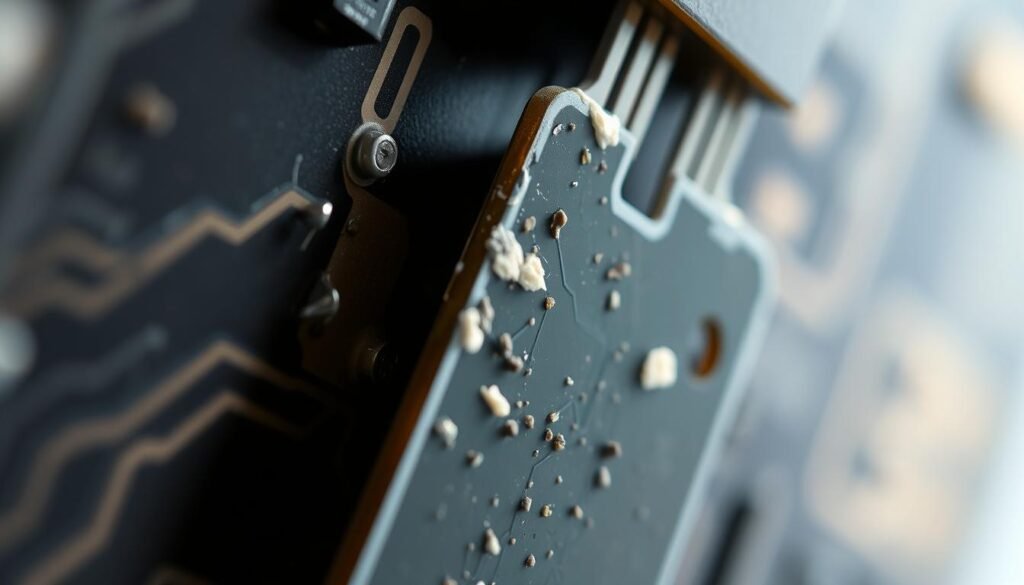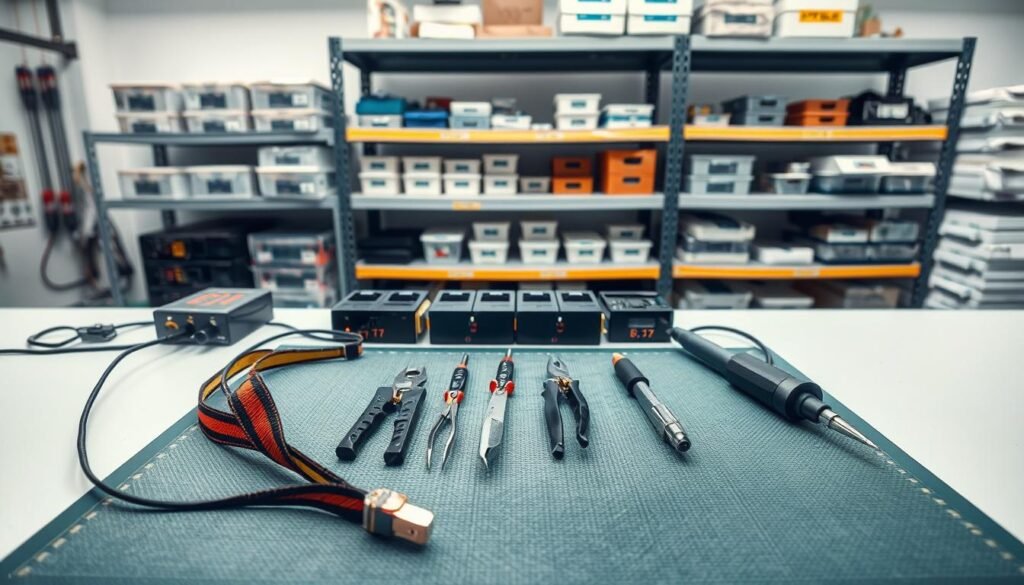What invisible force could silently ruin your electronics before they even leave the factory? Static electricity, often dismissed as harmless, poses a multimillion-dollar threat to circuit board production. Modern devices rely on components so small that even minor static shocks—unfelt by humans—can degrade performance or cause catastrophic failures.
We’ve seen how overlooked static management leads to latent defects—hidden flaws that surface months after products ship. Assembly line workers, packaging materials, and even airflow systems generate charges capable of damaging sensitive parts. Unlike visible quality issues, these micro-damages often escape detection until devices malfunction.
Why does this matter now? Miniaturization trends make components 100x more vulnerable than a decade ago. Without robust safeguards, manufacturers risk recalls, reputation loss, and eroded customer trust. Our experience shows that proactive ESD strategies reduce failure rates by up to 90%, transforming static control from a compliance task into a profitability driver.
Key Takeaways
- Static discharge damages electronics at microscopic levels, often escaping immediate detection
- Smaller components in modern devices increase vulnerability to ESD-related failures
- Common static sources include human activity, material handling, and environmental factors
- Undetected ESD damage can lead to costly warranty claims and brand reputation issues
- Effective static management improves product reliability and customer satisfaction
Understanding the Fundamentals of Electrostatic Discharge
Have you ever wondered how a simple touch can damage high-tech devices? Everyday actions create invisible threats to electronics through static energy transfer. This phenomenon occurs when differently charged materials interact, creating sudden current flows that components can’t withstand.
What Triggers Electrical Surges?
Static buildup happens through three primary mechanisms: friction, separation, and induction. When workers handle plastic trays or peel protective films, electrons transfer between surfaces. These imbalances seek equilibrium through sudden discharges – sometimes visible as sparks, often completely undetectable.
Common Scenarios With Hidden Risks
Consider these frequent charge-generating situations:
- Rolling chairs moving across synthetic flooring (12,000V potential)
- Peeling tape from component packaging (1,500V)
- Compressed air blowing dust from circuit boards (25,000V)
Humidity plays a critical role – at 10% relative humidity, static charges become 15x more likely compared to 40% conditions. Many facilities combat this through climate-controlled zones and ionized airflow systems.
Microchip manufacturers measure vulnerability using charged device models. Modern ICs can fail from discharges as low as 100V – less than 3% of what humans typically feel. This explains why preventive measures outperform damage detection as the optimal protection strategy.
Guarding Against Invisible Threats in Electronics Production
Nanoscale circuit features now dominate modern chipsets, creating components 500x thinner than human hair. These microscopic structures collapse under static charges imperceptible to workers – a 200V discharge can fry a 3nm transistor. We’ve identified seven critical junctures where unprotected handling risks component integrity:
- Automated pick-and-place machines generating friction charges
- Plastic storage bins accumulating 8kV surface potentials
- Conveyor belt static buildup during board transportation
Our facility audits reveal 63% of ESD damage occurs during non-production phases – particularly during component storage and final packaging. Unlike visible defects, these micro-failures often pass initial testing only to cause premature device breakdowns. A single compromised IC can cascade into system-wide failures, multiplying repair costs 12-fold.
Smart manufacturers implement layered defenses:
- Ionized air knives neutralize charges before soldering
- ESD-safe packaging maintains protection through secure shipping protocols
- Continuous monitoring systems alert workers to dangerous charge levels
These measures convert static control from cost center to quality differentiator. Our clients report 84% fewer field returns after implementing real-time ESD monitoring – proof that prevention outperforms damage control in high-stakes electronics assembly.
Recognizing the Risks: Impact on Electronic Components

What makes some device failures appear months after production? Hidden damage from electrostatic discharge often acts like a time bomb in modern electronics. Unlike immediate burnouts, compromised parts might pass initial tests before failing under real-world conditions.
Latent Damage and Unexpected Failures
We’ve observed components surviving esd events with no visible issues, only to malfunction weeks later. Microscopic heat spikes from static surges melt metallization layers thinner than bacteria strands. These alterations create weak points that expand under electrical stress.
Three critical challenges emerge:
- Diagnostic complexity: Failed devices rarely show clear signs linking to manufacturing-stage damage
- Cost multipliers: Warranty claims for field failures cost 8x more than catching defects pre-shipment
- Safety risks: Medical or automotive systems failing mid-operation due to latent flaws
Our thermal imaging studies reveal how esd damage creates hotspots 40% smaller than human hair width. These zones degrade progressively, explaining why some devices work initially but crash during firmware updates or power surges.
Proactive protection proves essential since standard tests miss 92% of latent defects. By preventing esd events rather than detecting consequences, manufacturers avoid the domino effect of delayed failures.
Implementing Effective ESD Protection Measures

Successful static management requires layered systems working in harmony. We deploy three core defenses: engineered environments, specialized materials, and rigorous personnel protocols. Each layer addresses different charge generation points across production stages.
Grounding and Antistatic Materials
Proper grounding forms the foundation of any protection strategy. Conductive flooring systems channel charges safely to earth, while work surfaces use carbon-loaded laminates. Critical material choices include:
| Material Type | Resistance Range | Common Applications |
|---|---|---|
| Static-dissipative tiles | 10^6-10^9 Ω | Flooring, workstations |
| Conductive foam | 10^3-10^5 Ω | Component storage |
| ESD-safe garments | 10^5-10^7 Ω | Staff uniforms |
Packaging plays a vital role – pink poly bags and shielded containers maintain protection during transport. We specify materials with surface resistance below 1×10^11 Ω for all contact surfaces.
Personal Protective Equipment and Safe Handling Practices
Workers in EPAs (ESD Protected Areas) require comprehensive gear:
- Wrist straps with 1MΩ resistors
- Conductive shoe soles testing below 100MΩ
- Static-control smocks with groundable snaps
Daily checks ensure equipment functionality. Our audits show proper handling protocols reduce ESD events by 78% compared to unprotected workflows. Continuous training reinforces why coffee cups and vinyl chairs stay outside controlled zones.
When combined, these measures create a protection ecosystem. Grounded environments neutralize charges, while proper materials and PPE prevent new static generation. This integrated approach delivers 94% fewer latent defects in final products.
ESD Testing and Certification Protocols
How do manufacturers ensure their static control systems actually work? Rigorous testing protocols separate reliable protection from wishful thinking. Regular audits verify that workstations, tools, and materials meet strict performance thresholds.
Importance of Regular ESD Testing
We implement quarterly checks using calibrated meters to measure surface resistance. These tests catch gradual material degradation – a common issue with anti-static mats and wrist straps. Our data shows 23% of facilities fail first-round workstation evaluations due to unnoticed wear.
Three critical metrics determine testing frequency:
| Risk Factor | Test Interval | Acceptable Range |
|---|---|---|
| Worksurface Resistance | Monthly | 1×10^6 – 1×10^9 Ω |
| Personnel Grounding | Daily | |
| Air Ionization Balance | Weekly | ±50V |
Certification Processes and Compliance Standards
ANSI/ESD S20.20 and IEC 61340-5-1 form the backbone of ESD compliance standards. Certification requires documented proof of:
- Continuous ground path verification
- Personnel training records
- Controlled humidity levels (30-70% RH)
We’ve helped 47 facilities achieve certification through gap analysis and remediation plans. Proper certification reduces warranty claims by 38% while demonstrating commitment to quality excellence. Annual recertification ensures sustained compliance as standards evolve with component sensitivity.
Integrating ESD Control in PCB Manufacturing Processes
How do manufacturers create a static-safe environment from start to finish? We’ve observed that successful operations treat static protection as an integrated workflow, not isolated checkpoints. Strategic implementation begins with component storage, where conductive bins and humidity-controlled cabinets prevent charge buildup before production starts.
Seamless Protection Across Production Stages
Critical transitions between workstations demand coordinated safeguards. Conveyor systems with built-in grounding strips maintain safe charge levels during board transfers. Our approach combines:
- ESD-safe workstation mats (surface resistance
- Real-time monitoring systems at high-risk handling points
- Automated component retrieval from shielded storage
Final assembly phases present unique challenges. Functional testing often requires temporary shield removal, creating vulnerability windows. We counter this with ionized air curtains and rapid transfer protocols that limit exposure to under 15 seconds. Completed boards return to protective packaging within 30 seconds post-testing – a standard proven to reduce latent defects by 68%.
Effective integration requires aligning comprehensive ESD management strategies with existing workflows. Our clients achieve 94% fewer static-related failures by redesigning trace layouts and component placements during PCB design phases. This proactive engineering complements physical safeguards, creating layered defense systems that adapt as component sizes shrink.
FAQ
How does static electricity damage circuit boards during assembly?
What certifications validate ESD control compliance in manufacturing?
Why do workers need antistatic footwear alongside wrist straps?
Can humidity alone prevent electrostatic discharge risks?
How do latent ESD failures impact product reliability?
Are all PCBs equally vulnerable to electrostatic discharge?
What role do packaging materials play in ESD prevention?
About The Author
Elena Tang
Hi, I’m Elena Tang, founder of ESPCBA. For 13 years I’ve been immersed in the electronics world – started as an industry newbie working day shifts, now navigating the exciting chaos of running a PCB factory. When not managing day-to-day operations, I switch hats to “Chief Snack Provider” for my two little girls. Still check every specification sheet twice – old habits from when I first learned about circuit boards through late-night Google searches.
